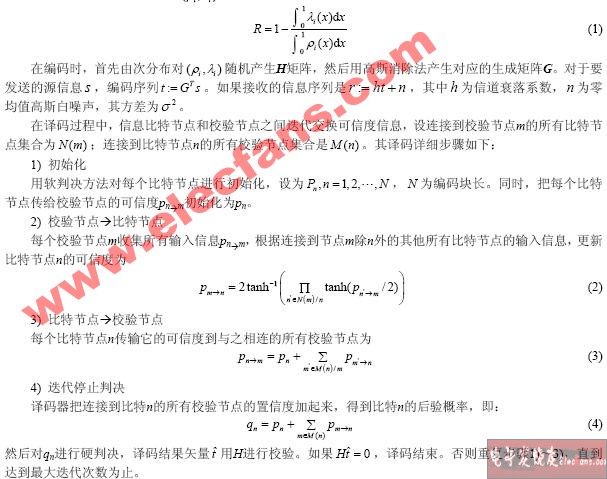LDPC code
The LDPC code is a linear block parity check code, which uses Belief PropagaTIon (BP) iterative decoding algorithm based on factor graph for decoding. Its performance is close to Turbo codes, and irregular LDPC codes even exceed Turbo code performance. Because the Turbo code adopts the puncturing method to adjust the code rate, a low-weight code word may be generated, resulting in a flattened bit error rate performance curve at a high signal-to-noise ratio [4]. The distance between the code words of the LDPC code will increase with the increase of the code length, so that its decoding errors can be detected. This feature has practical value, such as error-free transmission under the ARQ system.
The check matrix H of the LDPC code is a sparse matrix. For GF (2), the number of '1's in the rows and columns of H represents the degree of sub-distribution of each information bit and parity bit, respectively. "Row times" means the number of information bits participating in each test equation; "Column times" means the number of times each information bit participates in the test. The greater the "column order", the performance of the LDPC code can be arbitrarily close to the Shannon limit. However, if the "column order" is too large, the number of "circles" during decoding will increase sharply, which will seriously deteriorate the decoding performance. Generally, the "column order" is greater than 2. In addition, when the "column order" is equal to each column of H, it is called a regular LDPC code, otherwise it is an irregular LDPC code. Irregular LDPC codes have better performance than regular LDPC codes.
Assuming that the secondary distribution pair of LDPC codes is (,) iiÏλ, the code rate of LDPC [5]:

Analysis of code modulation performance of concatenated LDPC codes and CCK
Yuchai Generator Set,Industrial Generators,Waterproof Diesel Generator,Low Fuel Consumption Generator
Yangzhou Hengyuan Electromechanical Equipment Co., Ltd. , http://www.lchypower.com